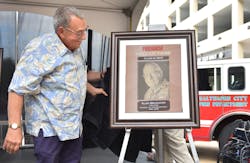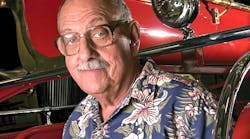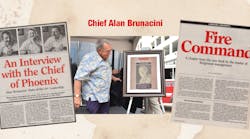Alan Brunacini, the former Phoenix Fire Chief and a familiar face at fire service conferences and meetings, passed away Sunday.
Brunacini, 80, joined the Phoenix Fire Department in 1958 and rose through the ranks to become fie chief in 1978. He retired in 2006.
Dennis Compton served as Brunacini's assistant chief for 15 years before he left to become fire chief in nearby Mesa.
“I think that working with Alan was like going to school every day," Compton said about Brunacini's urge to learn from and teach the fire service.
"In all of the research I've done in almost 50 years I don’t know of another Alan Brunacini and I doubt that there will be another one," Compton said. "I was fortunate with my 28 year working with Alan."
“I’ve known him so long that he didn’t wear Hawaiian shirts when we very first met,” former Newark, NJ, battalion chief and Firehouse Contributor Harry Carter said, noting how his longtime friend always wore Hawaiian shirts while teaching.
“He literally took me under his wing,” Carter said. "His influence on my career simply can’t be measured."
Carter, who will be inducted in to the Firehouse Hall of Fame at Firehouse Expo this week said, "I was looking forward to thanking him Thursday night."
The two met at a conference in 1976 and Brunacini later introduced the topic of firehouses as neighborhood franchises during one of Carter's sessions.
"He was always thinking, he had all these ideas and theories and he was only an assistant chief at the time."
Carter helped review Brunacini's book, Essentials of Fire Department Customer Service, that introduced "Mrs. Smith" to the fire service in the early 1980s.
“It was something I had never thought of, or encountered,” Carter said. “People would ask me a stop me in the yellow (fire chief's) car and ask me for directions. Instead of telling them directions, I would have them follow me. That’s the kind of customer service I would have my troops do.”
"I can still recall the energy generated by getting off the tailboards, calling Mrs. Smith a 'customer' and making the incident commander physically stay in the buggy," Brunacini wrote in an article for Firehouse Magazine's 40th anniversary last year.
His book, Fire Command, helped fire departments assess their operations and looked at their command structures.
Following the 2001 line-of-duty death of Phoenix firefighter Brett Tarver at a shopping center fire, Brunacini had the department research rapid intervention teams, incident command and air management and propelled a number of changes within the fire department.
Brunacini was a proponent of departments using the incident command system and created the Blue Card Command program with his sons, John and Nick.
The Eden Prairie, MN, Fire Department adoped the Blue Card concept years ago, Fire Chief George Esbensen said.
"Chief Brunacini turned the tragic death of one of his firefighters into a national movement to make firegrounds safer by educating fire commanders with a comprehensive but easy to apply incident management/risk management system which would eventually become the 'Blue Card' system in use nationally," Esbensen said. "Chief Brunacini impressed me with his humility and his willingness to venture into a journey of self reflection in order to make our business safer at its core."
Throughout his career, Brunacini served as chairman for NFPA standard 1500 - Technical Committee on Fire Department Occupational Safety and Health and 1710 - Standard for the Organization and Deployment of Fire Suppression Operations, Emergency Medical Operations, and Special Operations to the Public by Career Fire Departments.
He was also involved in the various research programs looking at fire science and behavior and firefighter health and safety.
"Despite his seniority, Chief Brunacini continued to learn the latest science of fire behavior and the impacts of modern furnishings and construction on firefighters and civilians," Esbensen said.
At Firehouse Expo in 2015, Brunacini was inducted in the inaugural Firehouse Hall of Fame class.
"Today is a day I had hoped would never come," Firehouse Editor-in-Chief Tim Sendelbach said. "Like most, Chief Brunacini became a mentor of mine the day I met him. Incredible charm, wit and wisdom with an insatiable passion for the fire service. His passing marks the end of an era, but his lessons will forever be shared by the generations of leaders he developed."
In a 2001 Firehouse Magazine interview, Brunacini said: "The only thing we keep for 30 years (in the Phoenix Fire Department) is a firefighter, so that's a pretty significant investment."
Steve Austin from the Cumberland Valley Volunteer Firemen's Association's Emergency Response Safety Institute called Brunacini brilliant.
"He didn’t set out to do that, but his work, personality and good nature are what made him who he was," Austin said. "He was committed to firefighter health and safety more than anyone."
Brunacini also championed many fire and life safety efforts, including the use of residential sprinklers.
"Chief Brunacini coined the phrase 'nothing unburns, but everything dries out' to help promote fire sprinkler efficacy," Esbensen said.
In an interview with Firehouse, he shared what he's learned through the years as he's traveled around the world, teaching on a variety of topics.
"It's been fascinating to me for years to go places and to learn the most unexpected things from the most unlikely people," Brunacini said in the 2001 interview. "After you do that a while, pretty soon you withhold judgment because you can go someplace that you think isn't a very refined kind of place, but if you shut up and pay attention to the people, they're doing some pretty neat stuff."
A celebration of life and legacy will be held Nov. 4, 1 p.m., at Comerica Theatre, 400 W. Washington St., Phoenix, AZ. Dress is casual and Hawaiian shirts are welcomed. If you're interested in bringing apparatus, contact Aaron Ernsberger at 602-501-9977.
In lieu of flowers, the family asks that donations be made to the Arizona Burn Center or the ASPCA.








